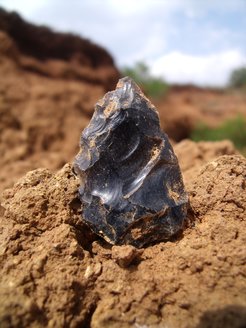New Neural Network Differentiates Middle and Late Stone Age Toolkits
By analyzing the tool forms that frequently occur together, researchers have developed a neural network that reliably distinguishes between Middle and Later Stone Age assemblages
MSA toolkits first appear some 300 thousand years ago, at the same time as the earliest fossils of Homo sapiens, and are still in use 30 thousand years ago. However, from 67 thousand years ago, changes in stone tool production indicate a marked shift in behaviour; the new toolkits that emerge are labelled LSA and remained in use into the recent past. A growing body of evidence suggests that the transition from MSA to LSA was not a linear process, but occurred at different times in different places. Understanding this process is important to examine what drives cultural innovation and creativity, and what explains this critical behavioural change. Defining differences between the MSA and LSA is an important step towards this goal.
"Eastern Africa is a key region to examine this major cultural change, not only because it hosts some of the youngest MSA sites and some of the oldest LSA sites, but also because the large number of well excavated and dated sites make it ideal for research using quantitative methods," says Dr. Jimbob Blinkhorn, an archaeologist from the Pan African Evolution Research Group, Max Planck Institute for the Science of Human History and the Centre for Quaternary Research, Department of Geography, Royal Holloway. "This enabled us to pull together a substantial database of changing patterns of stone tool production and use, spanning 130 to 12 thousand years ago, to examine the MSA-LSA transition."

The study examines the presence or absence of 16 alternate tool types across 92 stone tool assemblages, but rather than focusing on them individually, emphasis is placed on the constellations of tool forms that frequently occur together.
"We've employed an Artificial Neural Network (ANN) approach to train and test models that differentiate LSA assemblages from MSA assemblages, as well as examining chronological differences between older (130-71 thousand years ago) and younger (71-28 thousand years ago) MSA assemblages with a 94% success rate," says Dr. Matt Grove, an archaeologist at the University of Liverpool.
Artificial Neural Networks (ANNs) are computer models intended to mimic the salient features of information processing in the brain. Like the brain, their considerable processing power arises not from the complexity of any single unit but from the action of many simple units acting in parallel. Despite the widespread use of ANNs today, applications in archaeological research remain limited.
"ANNs have sometimes been described as a 'black box' approach, as even when they are highly successful, it may not always be clear exactly why," says Grove. "We employed a simulation approach that breaks open this black box to understand which inputs have a significant impact on the results. This enabled us to identify how patterns of stone tool assemblage composition vary between the MSA and LSA, and we hope this demonstrates how such methods can be used more widely in archaeological research in the future."

An example of a retouched point from Prospect Farm, a key feature of Middle Stone Age toolkits
"The results of our study show that MSA and LSA assemblages can be differentiated based on the constellation of artefact types found within an assemblage alone," Blinkhorn adds. "The combined occurrence of backed pieces, blade and bipolar technologies together with the combined absence of core tools, Levallois flake technology, point technology and scrapers robustly identifies LSA assemblages, with the opposite pattern identifying MSA assemblages. Significantly, this provides quantified support to qualitative differences noted by earlier researchers that key typological changes do occur with this cultural transition."
The team plans to expand the use of these methods to dig deeper into different regional trajectories of cultural change in the African Stone Age. "The approach we've employed offers a powerful toolkit to examine the categories we use to describe the archaeological record and to help us examine and explain cultural change amongst our ancestors," says Blinkhorn.

